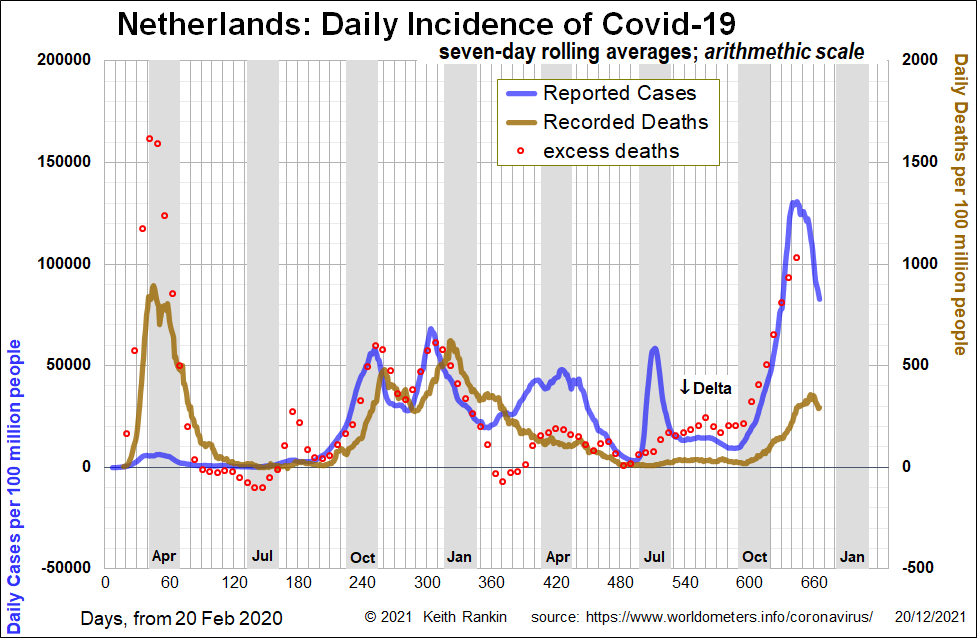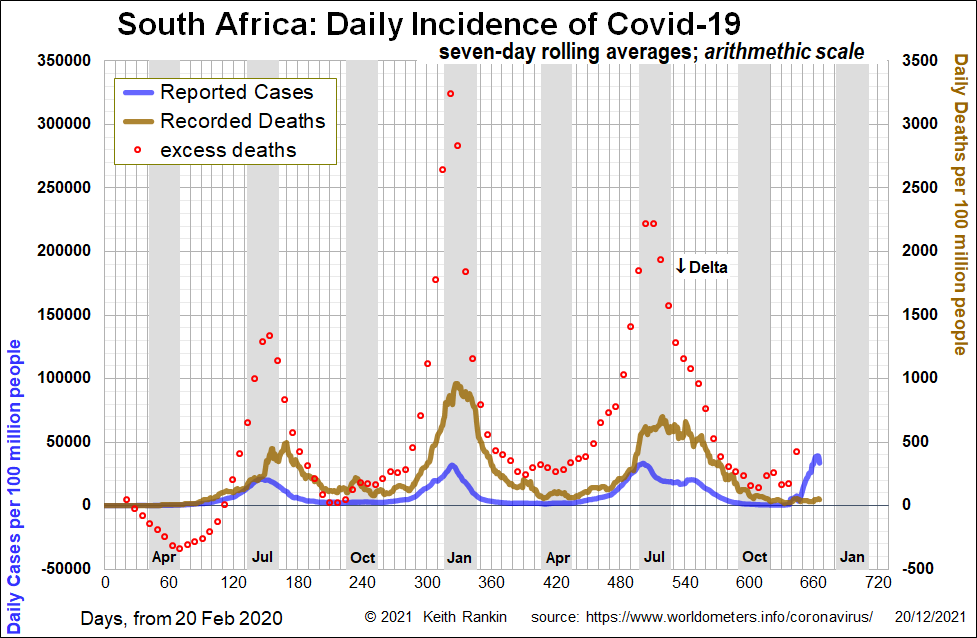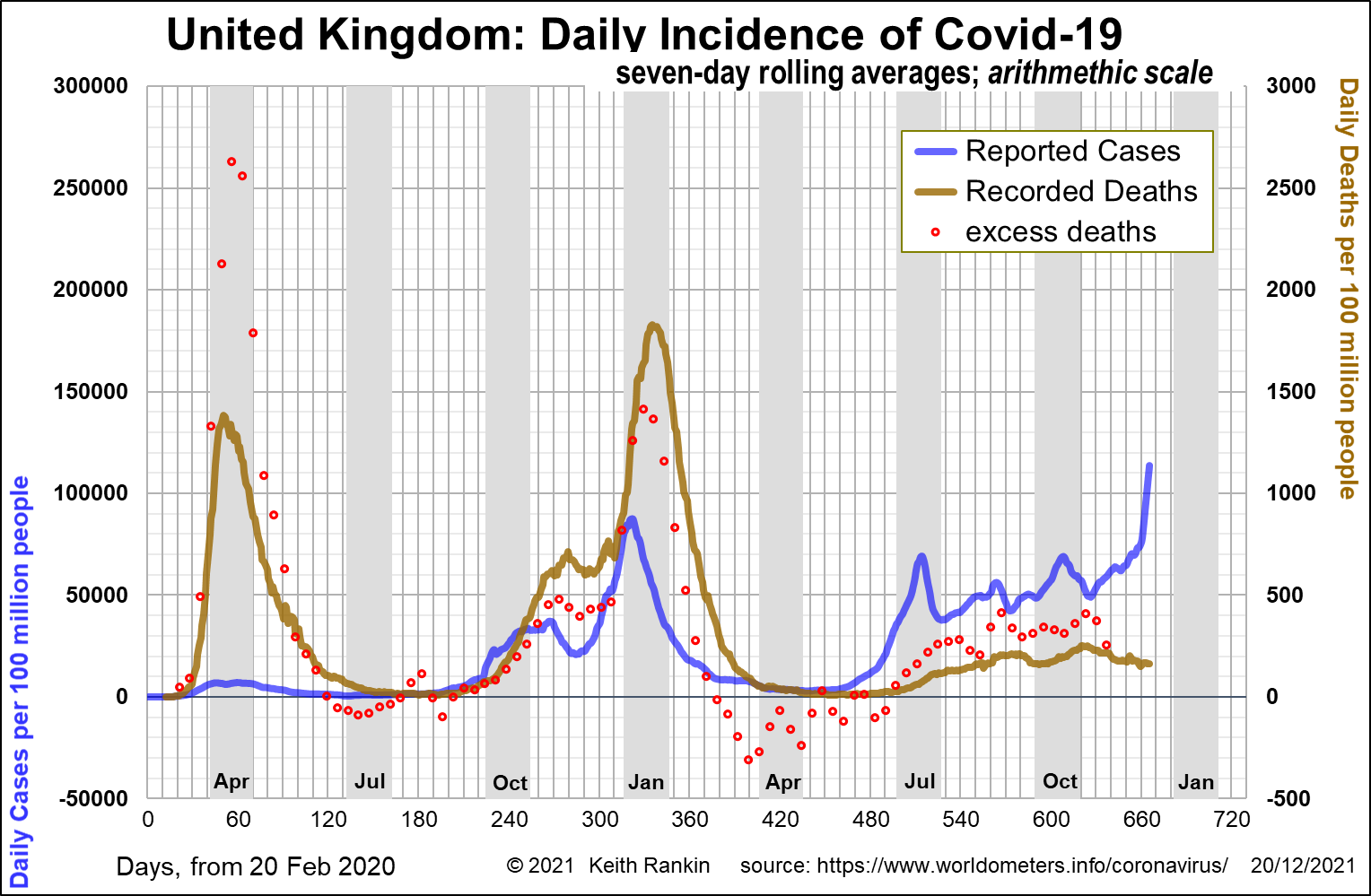Analysis by Keith Rankin.
Netherlands

While the Omicron strain of Covid19 was first sequenced in South Africa, it was found independently in the Netherlands in November. So, while Netherlands was one of the European countries which caught the latest sudden European wave (mainly featuring Delta), most likely the Omicron strain was already spreading there; indeed the main constraint on the growth of Omicron in Netherlands was probably Delta. By now, it seems that Omicron may have already largely displaced Delta. Based on excess deaths, the current wave of infections began in the Netherlands in early September, starting as a Delta wave.
Just as the Omicron panic reached its crescendo in Netherlands, the actual data shows a sharp decline in covid cases, following a similarly fast increase. Hospital admissions are also falling in Netherlands.
Coincident with the spike in cases was a spike in excess (Delta) deaths. For the deaths to be coincident with cases, it means that there was a prior undiagnosed beginning to the spike in cases. Netherlands has always been a country reluctant to surveillance test for Covid19, so we can assume that many early Omicron cases were never counted, just as numbers of early-wave Delta cases were not counted.
My interpretation of the very recent sharp fall in cases is that Omicron is displacing Delta, and because Omicron is less severe than Delta, many Omicron cases are either completely asymptomatic, or mild ‘cold’ symptoms that have not triggered a covid test.
Why the political panic when known cases are falling sharply? My guess is that it’s politics. When things go wrong, Prime Ministers prefer to claim that they were blindsided by something quite unexpected than to admit to having been negligent. Hence, in Netherlands especially, the Omicron scare has all the appearance of being overcooked; of being a politically convenient (or manufactured) crisis.
South Africa

South Africa had a winter wave of covid cases from June to August 2021; a mix of the Beta and Delta variants. October was comparatively quiet, though increased deaths at the end of October suggest at least one region remained covid active. Then the Omicron variant appeared in early November, evidently from Botswana. The sharp rise in cases in South Africa – Omicron – almost certainly began about a week into November, three weeks ahead of what shows on the chart. It’s unlikely that the rise in excess deaths in late November was due to Omicron – it’s just a bit too soon.
Certainly, by December the authorities were sensitised to look for Covid19 amongst deaths, with particular reference to Omicron. But so far covid deaths in South Africa remain very low, despite it now being seven weeks since Omicron has been there. Despite South Africa having a ‘young’ population, it clearly has a covid-vulnerable population, looking at previous waves.
In early December, the rate of discovery of Omicron significantly exceeded Omicron’s rate of transmission. We note now that case numbers in South Africa seem to have peaked.
United Kingdom

In the United Kingdom – Covid19, mainly Delta – has been significantly present since June. Deaths have been low (by 2020 standards) and stable, at about three per million people per day. That looks now to be down to two per million per day (equivalent to 10 daily covid deaths in New Zealand).
This December, it looks as though a rapid escalation of cases – Omicron cases – has been taking place. But much of this represents the rate of discovery, not the rate of transmission. Quite possibly many of the November cases were also Omicron, and many cases of Omicron in November will not have been notified because they were too mild to have triggered a test. Severe cases of Omicron should already be showing in the death data, but they are not. This suggests that relatively few cases of this variant are severe.
As in the Netherlands, I cannot help but feel that there is a lot of unnecessary hype about Omicron in the United Kingdom. Prime Minister Boris Johnson is facing a major political scandal over his staff’s 2020 Christmas Party. Omicron is a convenient if untidy distraction.
Reflection
The biggest concern, I would argue, is that the populations of ‘the west’ are now close to a ‘critical threshold’ (or ‘tipping point’) of anxiety over the pandemic (see The straw that broke the camel’s back for the idea of a ‘critical threshold’ or ‘critical state’). (‘Critical state’ theory is very important for the understanding and prediction of major earthquakes.)
It looks likely that Omicron is evolutionarily superior to Delta because, in the vast majority of cases, it is not creating severe illness in its human hosts. If this is correct, Omicron is not merely ‘coldlike’ as has been described; rather it is a ‘cold’ virus, as is former-pandemic coronavirus OC43.This should be being hailed as good news, and not as an invitation for the human species to go mad with fear. Omicron is dealing to Delta, methinks. Sometimes the solution to a virus is a virus; that’s ecology.
——-
Keith Rankin (keith at rankin dot nz), trained as an economic historian, is a retired lecturer in Economics and Statistics. He lives in Auckland, New Zealand.







